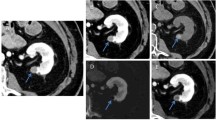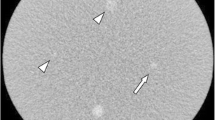Abstract
Purpose
Prior iterative reconstruction (PIR) spatially registers CT image data from multiple phases of enhancement to reduce image noise. We evaluated PIR in contrast-enhanced multiphase liver CT.
Methods
Patients with archived projection CT data with proven malignant or benign liver lesions, or without lesions, by reference criteria were included. Lower-dose PIR images were reconstructed using validated noise insertion from multiphase CT exams (50% dose in 2 phases, 25% dose in 1 phase). The phase of enhancement most relevant to the diagnostic task was selected for evaluation. Four radiologists reviewed routine-dose and lower-dose PIR images, circumscribing liver lesions and rating confidence for malignancy (0 to 100) and image quality. JAFROC Figures of Merit (FOM) were calculated.
Results
31 patients had 60 liver lesions (28 primary hepatic malignancies, 6 hepatic metastases, 26 benign lesions). Pooled JAFROC FOM for malignancy for routine-dose CT was 0.615 (95% CI 0.464, 0.767) compared to 0.662 for PIR (95% CI 0.527, 0.797). The estimated FOM difference between the routine-dose and lower-dose PIR images was + 0.047 (95% CI − 0.023, + 0.116). Pooled sensitivity/specificity for routine-dose images was 70%/68% compared to 73%/66% for lower-dose PIR. Lower-dose PIR had lower diagnostic image quality (mean 3.8 vs. 4.2, p = 0.0009) and sharpness (mean 2.3 vs. 2.0, p = 0.0071).
Conclusions
PIR is a promising method to reduce radiation dose for multiphase abdominal CT, preserving observer performance despite small reductions in image quality. Further work is warranted.






Similar content being viewed by others
References
McCollough CH, Guimaraes L, Fletcher JG (2009) In defense of body CT. AJR Am J Roentgenol 193 (1):28-39.
Verdun FR, Gutierrez D, Schnyder P, Aroua A, Bochud F, Gudinchet F (2007) CT dose optimization when changing to CT multi-detector row technology. Curr Probl Diagn Radiol 36 (4):176-184.
Padole A, Ali Khawaja RD, Kalra MK, Singh S (2015) CT radiation dose and iterative reconstruction techniques. AJR Am J Roentgenol 204 (4):W384-392.
Power SP, Moloney F, Twomey M, James K, O’Connor OJ, Maher MM (2016) Computed tomography and patient risk: Facts, perceptions and uncertainties. World J Radiol 8 (12):902-915.
Ohashi I, Hanafusa K, Yoshida T (1993) Small hepatocellular carcinomas: two-phase dynamic incremental CT in detection and evaluation. Radiology 189 (3):851-855.
Virmani V, Ramanathan S, Virmani VS, Kielar A, Sheikh A, Ryan J (2014) Non-neoplastic hepatic vascular diseases: spectrum of CT and MRI appearances. Clin Radiol 69 (5):538-548.
Lamba R, Fananapazir G, Corwin MT, Khatri VP (2014) Diagnostic imaging of hepatic lesions in adults. Surg Oncol Clin N Am 23 (4):789-820.
Pang EH, Harris AC, Chang SD (2016) Approach to the Solitary Liver Lesion: Imaging and When to Biopsy. Can Assoc Radiol J 67 (2):130-148.
Smith-Bindman R, Wang Y, Yellen-Nelson TR, Moghadassi M, Wilson N, Gould R, Seibert A, Boone JM, Krishnam M, Lamba R, Hall DJ, Miglioretti DL (2017) Predictors of CT Radiation Dose and Their Effect on Patient Care: A Comprehensive Analysis Using Automated Data. Radiology 282 (1):182-193.
Goldman AR, Maldjian PD (2013) Reducing radiation dose in body CT: a practical approach to optimizing CT protocols. AJR Am J Roentgenol 200 (4):748-754.
Perri RE, Chiorean MV, Fidler JL, Fletcher JG, Talwalkar JA, Stadheim L, Shah ND, Kamath PS (2008) A prospective evaluation of computerized tomographic (CT) scanning as a screening modality for esophageal varices. Hepatology 47 (5):1587-1594.
Singh S, Kalra MK, Gilman MD, Hsieh J, Pien HH, Digumarthy SR, Shepard JA (2011) Adaptive statistical iterative reconstruction technique for radiation dose reduction in chest CT: a pilot study. Radiology 259 (2):565-573.
Winklehner A, Karlo C, Puippe G, Schmidt B, Flohr T, Goetti R, Pfammatter T, Frauenfelder T, Alkadhi H (2011) Raw data-based iterative reconstruction in body CTA: evaluation of radiation dose saving potential. Eur Radiol 21 (12):2521-2526.
Sauter A, Koehler T, Fingerle AA, Brendel B, Richter V, Rasper M, Rummeny EJ, Noel PB, Munzel D (2016) Ultra Low Dose CT Pulmonary Angiography with Iterative Reconstruction. PLoS One 11 (9):e0162716.
den Harder AM, Willemink MJ, de Ruiter QM, Schilham AM, Krestin GP, Leiner T, de Jong PA, Budde RP (2015) Achievable dose reduction using iterative reconstruction for chest computed tomography: A systematic review. Eur J Radiol 84 (11):2307-2313.
Den Harder AM, Willemink MJ, De Ruiter QM, De Jong PA, Schilham AM, Krestin GP, Leiner T, Budde RP (2016) Dose reduction with iterative reconstruction for coronary CT angiography: a systematic review and meta-analysis. Br J Radiol 89 (1058):20150068.
Mileto A, Zamora DA, Alessio AM, Pereira C, Liu J, Bhargava P, Carnell J, Cowan SM, Dighe MK, Gunn ML, Kim S, Kolokythas O, Lee JH, Maki JH, Moshiri M, Nasrullah A, O’Malley RB, Schmiedl UP, Soloff EV, Toia GV, Wang CL, Kanal KM (2018) CT Detectability of Small Low-Contrast Hypoattenuating Focal Lesions: Iterative Reconstructions versus Filtered Back Projection. Radiology 289 (2):443-454.
Jensen CT, Wagner-Bartak NA, Vu LN, Liu X, Raval B, Martinez D, Wei W, Cheng Y, Samei E, Gupta S (2018) Detection of Colorectal Hepatic Metastases Is Superior at Standard Radiation Dose CT versus Reduced Dose CT. Radiology 290:400-409.
Fletcher JG, Fidler JL, Venkatesh SK, Hough DM, Takahashi N, Yu L, Johnson M, Leng S, Holmes DR, 3rd, Carter R, McCollough CH (2018) Observer Performance with Varying Radiation Dose and Reconstruction Methods for Detection of Hepatic Metastases. Radiology 289 (2):455-464.
Fletcher JG, Yu L, Fidler JL, Levin DL, DeLone DR, Hough DM, Takahashi N, Venkatesh SK, Sykes AG, White D, Lindell RM, Kotsenas AL, Campeau NG, Lehman VT, Bartley AC, Leng S, Holmes DR, 3rd, Toledano AY, Carter RE, McCollough CH (2017) Estimation of Observer Performance for Reduced Radiation Dose Levels in CT: Eliminating Reduced Dose Levels That Are Too Low Is the First Step. Acad Radiol 24 (7):876-890.
Yu L, Shiung M, Jondal D, McCollough CH (2012) Development and validation of a practical lower-dose-simulation tool for optimizing computed tomography scan protocols. J Comput Assist Tomogr 36 (4):477-487.
Froemming AT, Kawashima A, Takahashi N, Hartman RP, Nathan MA, Carter RE, Yu L, Leng S, Kagoshima H, McCollough CH, Fletcher JG (2013) Individualized kV selection and tube current reduction in excretory phase computed tomography urography: potential for radiation dose reduction and the contribution of iterative reconstruction to image quality. J Comput Assist Tomogr 37 (4):551-559.
Baker ME, Dong F, Primak A, Obuchowski NA, Einstein D, Gandhi N, Herts BR, Purysko A, Remer E, Vachhani N (2012) Contrast-to-noise ratio and low-contrast object resolution on full- and low-dose MDCT: SAFIRE versus filtered back projection in a low-contrast object phantom and in the liver. AJR Am J Roentgenol 199 (1):8-18.
Goenka AH, Herts BR, Dong F, Obuchowski NA, Primak AN, Karim W, Baker ME (2016) Image Noise, CNR, and Detectability of Low-Contrast, Low-Attenuation Liver Lesions in a Phantom: Effects of Radiation Exposure, Phantom Size, Integrated Circuit Detector, and Iterative Reconstruction. Radiology 280 (2):475-482.
Pooler BD, Lubner MG, Kim DH, Chen OT, Li K, Chen GH, Pickhardt PJ (2017) Prospective Evaluation of Reduced Dose Computed Tomography for the Detection of Low-Contrast Liver Lesions: Direct Comparison with Concurrent Standard Dose Imaging. Eur Radiol 27 (5):2055-2066.
McCollough CH, Yu L, Kofler JM, Leng S, Zhang Y, Li Z, Carter RE (2015) Degradation of CT Low-Contrast Spatial Resolution Due to the Use of Iterative Reconstruction and Reduced Dose Levels. Radiology 276 (2):499-506.
Schindera ST, Odedra D, Raza SA, Kim TK, Jang HJ, Szucs-Farkas Z, Rogalla P (2013) Iterative reconstruction algorithm for CT: can radiation dose be decreased while low-contrast detectability is preserved? Radiology 269 (2):511-518.
Holden M (2008) A review of geometric transformations for nonrigid body registration. IEEE Trans Med Imaging 27 (1):111-128.
Acknowledgements
Authors wish to express appreciation to Kris Nunez for her assistance in preparation of the manuscript.
Funding
This work was funded in part by a research grant to the author’s institution from Siemens Healthineers.
Author information
Authors and Affiliations
Corresponding author
Ethics declarations
Conflict of interest
Dr. Halaweish is an employee of Siemens Healthineers. Drs. McCollough and Fletcher received grant support for their institution from Siemens Healthineers, which provided the offline computer workstation and prior iterative reconstruction software examined in this work.
Additional information
Publisher's Note
Springer Nature remains neutral with regard to jurisdictional claims in published maps and institutional affiliations.
Rights and permissions
About this article
Cite this article
Mohammadinejad, P., Ehman, E.C., Vasconcelos, R.N. et al. Prior iterative reconstruction (PIR) to lower radiation dose and preserve radiologist performance for multiphase liver CT: a multi-reader pilot study. Abdom Radiol 45, 45–54 (2020). https://doi.org/10.1007/s00261-019-02280-0
Published:
Issue Date:
DOI: https://doi.org/10.1007/s00261-019-02280-0




